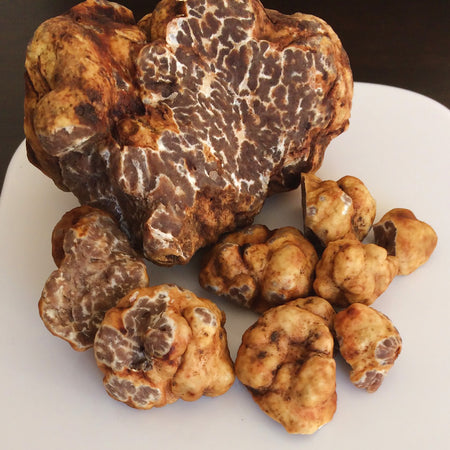ENGLISH OAK TREES INOCULATED W/ BIANCHETTO TRUFFLES
Product Description:
The Bianchetto truffle is a highly prized Italian species. Its name indicates the whitish coloration in contrast to blackish truffles. Inside, the flesh is brown with white marbling, and the strong aroma is described as earthy, garlicy and cheesy. The hazelnut to golf ball-sized truffles lend themselves to a vast array of recipes.
Note: Bianchetto truffles require a soil pH between 6.0-8.3. If your soil is more acidic, we recommend preparing your planting area with lime to adjust the pH well in advance of receiving your trees.
Inoculated, 1 year old Truffle Tree seedlings start shipping in March until sold out or in early December. Order early for best availability. Available only within the contiguous US.
| Plant Spacing | 40-60' |
| Plant height | 30-65' at maturity |
| Hardiness Zone | 6-9 |
| Bearing Age | 3-5 years |
| Ripening Time | Winter |
| Pollinator Required | No |
Quercus robur (English Oak) & Tuber borchii (Bianchetto truffle)
Initial Instructions
Your truffle tree should be planted in the ground as soon as possible. If you are unable to plant immediately, the tree can be temporarily placed in a 2-gallon pot filled with natural soil amended with 50% perlite, and 5% agricultural lime by volume. Place in a cool area and water the tree gently with a mist nozzle to prevent compaction of the soil. It is important to complete the soil preparation before planting the tree. Truffle farming is a new science, and results are less predictable than with most other crops.
Site Selection
Bianchetto truffles are found in a wide range of soils and climates, and occur naturally throughout most of Europe. Truffles receive their energy from sugars produced by the host tree. It is therefore essential to give your truffle tree full sun all day without competition for light from neighboring trees. The soils where truffles live naturally are always very well drained with no standing water at any time of the year and a seasonal high water table well below the rooting zone of the tree. Truffles are unlikely to grow well in wet soils.
Preparation & Planting
Natural bianchetto truffle patches have soil pH ranging between 7 and 8, which is high for most parts of the U.S. with mild winters. Most growers therefore amend the soil with calcium carbonate lime (agricultural lime) to raise the pH before planting their trees. This often requires on the order of 350 pounds of lime spread in a radius 15+ feet from the tree, and worked into the soil to a depth of at least six inches. You can also get a more precise lime recommendation to reach a soil pH of 7.0 from a soil testing laboratory. The tree can be planted immediately after the lime is worked into the soil even though lime takes two or more years to have its full effect on soil pH. After two years, pH should be tested annually to determine whether supplemental lime is needed (it is essential to use only calcium carbonate, no other chemical formulations of lime). Dig a hole approximately one foot deep and one foot wide, remove the pot and place the tree in the hole. Fill the soil around the root plug, keeping the top of the root plug even with the soil surface. Do not amend the soil with compost, and fertilize lightly, if at all. If soil is heavy, it can be beneficial to amend it generously with pea gravel or perlite to improve aeration.
Cultivation
Like all perennials, your truffle tree will grow more rapidly and the truffle is more likely to thrive on its roots if weeds and grass are eliminated within several feet of the tree. Beyond that, mowing is sufficient. Light cultivation of the soil around the tree once in early spring (March or April, weather permitting) is helpful to control weeds and to aerate the soil, improving the vigor of truffle mycorrhizae. Do not cultivate the soil at any other time of year. Hand weeding or a propane weeding torch are the best ways to eliminate unwanted vegetation through the rest of the year. Some pruning will eventually become necessary for weed control and aesthetics, but the truffles will fruit best in shady conditions beneath the tree's canopy. Regular watering through dry weather is essential to ensure a crop.
Size at Maturity
Your oak tree will develop into a large, deciduous shade tree with a maximum height and width of 30-65 feet. Your truffles should fruit well before that, though. You can plant multiple trees closer together to produce more shade beneath them.
Harvest
Bianchetto truffles can fruit in 3-5 years, or longer if the trees are stressed by weeds, pests, or lack of water. They ripen underground between January and April. Most growers find their first truffles either poking through the soil surface, or where squirrels have unearthed them, but harvesting will eventually require a trained dog to sniff them out.




